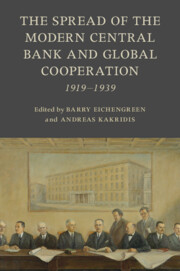136 results
Part I - General
-
- Book:
- The Spread of the Modern Central Bank and Global Cooperation
- Published online:
- 02 November 2023
- Print publication:
- 16 November 2023, pp 1-102
-
- Chapter
- Export citation
Preface
-
- Book:
- The Spread of the Modern Central Bank and Global Cooperation
- Published online:
- 02 November 2023
- Print publication:
- 16 November 2023, pp xix-xx
-
- Chapter
- Export citation
Copyright page
-
- Book:
- The Spread of the Modern Central Bank and Global Cooperation
- Published online:
- 02 November 2023
- Print publication:
- 16 November 2023, pp viii-viii
-
- Chapter
- Export citation
1 - Interwar Central Banks
- from Part I - General
-
-
- Book:
- The Spread of the Modern Central Bank and Global Cooperation
- Published online:
- 02 November 2023
- Print publication:
- 16 November 2023, pp 3-39
-
- Chapter
- Export citation
Figures
-
- Book:
- The Spread of the Modern Central Bank and Global Cooperation
- Published online:
- 02 November 2023
- Print publication:
- 16 November 2023, pp xi-xii
-
- Chapter
- Export citation
Index
-
- Book:
- The Spread of the Modern Central Bank and Global Cooperation
- Published online:
- 02 November 2023
- Print publication:
- 16 November 2023, pp 406-422
-
- Chapter
- Export citation
Editors and Contributors
-
- Book:
- The Spread of the Modern Central Bank and Global Cooperation
- Published online:
- 02 November 2023
- Print publication:
- 16 November 2023, pp xv-xviii
-
- Chapter
- Export citation
Tables
-
- Book:
- The Spread of the Modern Central Bank and Global Cooperation
- Published online:
- 02 November 2023
- Print publication:
- 16 November 2023, pp xiii-xiv
-
- Chapter
- Export citation
Part II - Specific
-
- Book:
- The Spread of the Modern Central Bank and Global Cooperation
- Published online:
- 02 November 2023
- Print publication:
- 16 November 2023, pp 103-405
-
- Chapter
- Export citation
Contents
-
- Book:
- The Spread of the Modern Central Bank and Global Cooperation
- Published online:
- 02 November 2023
- Print publication:
- 16 November 2023, pp ix-x
-
- Chapter
- Export citation

The Spread of the Modern Central Bank and Global Cooperation
- 1919–1939
-
- Published online:
- 02 November 2023
- Print publication:
- 16 November 2023
1 - Conceptual Foundations of Economic and Monetary Union
- from Part I - The Economic and Monetary Union
-
-
- Book:
- The Cambridge Handbook of European Monetary, Economic and Financial Integration
- Published online:
- 28 September 2023
- Print publication:
- 12 October 2023, pp 19-32
-
- Chapter
- Export citation
18 - International Finance
- from Part II - Factors Governing Differential Outcomes in the Global Economy
-
-
- Book:
- The Cambridge Economic History of the Modern World
- Published online:
- 03 June 2021
- Print publication:
- 24 June 2021, pp 501-525
-
- Chapter
- Export citation
5 - Exchange Rates, Capital Flows and the Financial Cycle
-
-
- Book:
- Promoting Global Monetary and Financial Stability
- Published online:
- 10 April 2020
- Print publication:
- 30 April 2020, pp 168-205
-
- Chapter
- Export citation
Capitalism in America: A History. By Alan Greenspan and Adrian Wooldridge. New York: Penguin Press, 2018. Pp. 496. $22.48, hardcover. - Keeping At It: The Quest for Sound Money and Good Government. By Paul Volcker with Christine Harper. New York: Public Affairs, 2018. Pp. 304. $18.30, hardcover.
-
- Journal:
- The Journal of Economic History / Volume 79 / Issue 2 / June 2019
- Published online by Cambridge University Press:
- 11 July 2019, pp. 571-574
- Print publication:
- June 2019
-
- Article
- Export citation
11 - The Two Eras of Central Banking in the United States
-
-
- Book:
- Sveriges Riksbank and the History of Central Banking
- Published online:
- 10 May 2018
- Print publication:
- 24 May 2018, pp 361-387
-
- Chapter
- Export citation
What Macroeconomic Measures Are Needed for Free Trade to Flourish in the Western Hemisphere?
-
- Journal:
- Latin American Politics and Society / Volume 46 / Issue 2 / Summer 2004
- Published online by Cambridge University Press:
- 02 January 2018, pp. 1-27
-
- Article
- Export citation
15 - Euro Area Risk (Mis)management
- from Part IV - Case Studies of Financial Crises
-
-
- Book:
- Policy Shock
- Published online:
- 24 October 2017
- Print publication:
- 02 November 2017, pp 371-394
-
- Chapter
- Export citation
7 - A Century and a Half of Central Banks, International Reserves, and International Currencies
-
-
- Book:
- Central Banks at a Crossroads
- Published online:
- 05 June 2016
- Print publication:
- 09 June 2016, pp 280-318
-
- Chapter
- Export citation
2 - Doctrinal Determinants, Domestic and International, of Federal Reserve Policy 1914–1933
-
-
- Book:
- The Federal Reserve's Role in the Global Economy
- Published online:
- 05 March 2016
- Print publication:
- 01 April 2016, pp 14-49
-
- Chapter
- Export citation

